Murder at the Foul Line: Original Tales of Hoop Dreams and Deaths from Today's Great Writers
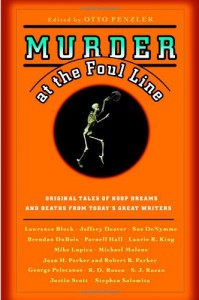 In 2006, Otto Penzler released the anthology Murder at the Foul Line, with stories contributed by a Who's Who of crime fiction, including Michael Malone's winningly deadpan "White Trash Noir," about domestic violence from a former NCAA star that seemingly drives his wife to murder. It was nominated for the 2007 Edgar Award for best short story, but had to be withdrawn because it had been previously published in a collection by the author. There are other winners, though: Lawrence Block's hitman character Keller takes in a Pacers game in "Keller's Double Dribble," but the assignment doesn't go as planned and we get glimpses into Keller's past; "String Music" by George Pelecanos focuses on a streetwise D.C. kid trying to escape his troubled life by playing pickup basketball; Laurie R. King's "Cat's Paw" features the coach of a girl's junior high basketball team who is haunted by repressed memories and whose life is shaken up after she runs over a cat; and Jeffery Deaver's "Nothing But Net" is filled with Deaver's trademark twists and turns, featuring con men trying to swindle a naive NBA player.
In 2006, Otto Penzler released the anthology Murder at the Foul Line, with stories contributed by a Who's Who of crime fiction, including Michael Malone's winningly deadpan "White Trash Noir," about domestic violence from a former NCAA star that seemingly drives his wife to murder. It was nominated for the 2007 Edgar Award for best short story, but had to be withdrawn because it had been previously published in a collection by the author. There are other winners, though: Lawrence Block's hitman character Keller takes in a Pacers game in "Keller's Double Dribble," but the assignment doesn't go as planned and we get glimpses into Keller's past; "String Music" by George Pelecanos focuses on a streetwise D.C. kid trying to escape his troubled life by playing pickup basketball; Laurie R. King's "Cat's Paw" features the coach of a girl's junior high basketball team who is haunted by repressed memories and whose life is shaken up after she runs over a cat; and Jeffery Deaver's "Nothing But Net" is filled with Deaver's trademark twists and turns, featuring con men trying to swindle a naive NBA player.Murder at the Foul Line is the fifth installment in Penzler's sports mystery anthology series, so if you're not a fan of basketball, instead try Murderer's Row (baseball), Murder on the Ropes (boxing), Murder is My Racquet (tennis) and Sudden Death (football). I should point out that these books were published by the defunct New Millennium publishing arm, and that Penzler successfully sued the company claiming breach of contract. It's an unfortunate conclusion to what was originally an intriguing collaboration, but that doesn't change the fact the stories still stand on their own, with many sparkling three-pointers among them.
An Air That Kills
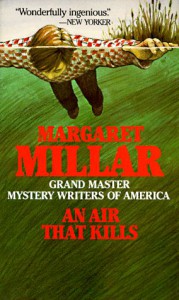 Margaret Millar (1915-1994) was married to Kenneth Millar, better known as crime fiction author Ross MacDonald, but despite having an Edgar Award and over 25 novels to her credit (with some critics saying she was the better writer of the two), she never gained the same popularity as her husband.
Margaret Millar (1915-1994) was married to Kenneth Millar, better known as crime fiction author Ross MacDonald, but despite having an Edgar Award and over 25 novels to her credit (with some critics saying she was the better writer of the two), she never gained the same popularity as her husband. The Millars made a good writing team, such as the times Margaret helped her husband with dialogue. "I did teach him to write better dialogue so that everybody didn't sound like him. In the first two books, all of the characters talked like Ken! I don't even know anybody who talks like Ken. And I told him he had to listen...And we went around to a lot of places: pawn shops, low bars...And he realized how different people talk." Apparently, Kenneth also once said that the best lines usually resulted from the many arguments the couple had.
The Soft Talkers is the U.K. title for Margaret Millar's novel from 1957, originally released in the U.S. as An Air That Kills. It follows the seemingly perfect married couple, Harry and Thelma Bream. Harry's best friend Ron Galloway invites his pals to his lakeside hunting lodge for the weekend, but then fails to show up. The worried friends call Galloway's house and speak to his wife, Esther, to find out what's keeping him, but the wife tells them Galloway left a long time ago. Then Thelma drops the bombshell on friend-caught-in the-middle Ralph Turee that she is pregnant with Ron's child. The investigation grows cold, and it isn't until much time has passed, when Ron is found dead buckled into his submerged convertible, that the even colder, twisted truth comes to light.
Millar's attention to dialogue is evident, part of the meticulous detail she gives to building her characters. Although she admittedly wasn't a fan of action-driven plots, her meticulous weaving of plot, clues and misdirection are all in fine form here, as is her zingy prose, examples of which you can find on nearly every page, like these:
--He had a sensation that he and Harry were stationary and the night was moving past them swiftly, turbulent with secrets. To the right the bay was visible in the reflection of a half moon. The waves nudged each other and winked slyly and whispered new secrets.
--Thelma, the day-dreamer, who fed her mediocrity with meaty chunks of dreams until it was fat beyond her own recognition. Under this system of mental dietetics Thelma became a woman equpped with great psychic powers...
--It was merely the skeleton of the truth. Only an expert could add the flesh and blood and muscle and all the vital organs that would make it a whole, borrowing a little here, a little there...
Although it's a shame Millar isn't as well known as MacDonald, it's nice to see that a couple of her novels have been reissued recently by Stark House Press. Maybe new readers can discover why Anthony Boucher said of her writing, "Devilishly devious trick-plotting given substance by acute and terrifying psychological insight."
Murder In The Borough Library
 John Austwick, a pseudonym for Austin Lee (1904-1965), served as a Royal Navy chaplain in the 1930s and later became a rector and vicar in rural England. Reverend Lee was a "character" for his times, a socialist and a pacifist who once said he was the "despair of Bishops," and in every Church job he held, he soon found himself in the newspapers complaining about the paltry stipend, lack of challenges, and dictatorial nature of the church hierarchy. It's hardly surprising that he was relieved of his Navy chaplaincy. In-between church jobs, he worked as a bartender, journalist, chef, and writer of guide books for the Norwegian railways.
John Austwick, a pseudonym for Austin Lee (1904-1965), served as a Royal Navy chaplain in the 1930s and later became a rector and vicar in rural England. Reverend Lee was a "character" for his times, a socialist and a pacifist who once said he was the "despair of Bishops," and in every Church job he held, he soon found himself in the newspapers complaining about the paltry stipend, lack of challenges, and dictatorial nature of the church hierarchy. It's hardly surprising that he was relieved of his Navy chaplaincy. In-between church jobs, he worked as a bartender, journalist, chef, and writer of guide books for the Norwegian railways.The author's first and primary series character (under his given name, Austin Lee) was schoolmistress turned detective Miss Hogg, who starred in nine novels, basically one a year from 1955 to 1963. Simultaneously with those books, he created a series featuring Detective Inspector Parker, with five installments including three that seem to indicate an obsession with libraries: "Murder in the Borough Library" (1959), "The County Library Murders" (1962) and "The Mobile Library Murders" (1964). Why? Perhaps it was because he wrote many of his novels in the Keighley Reference Library.
The book "Murder in the Borough Library" finds DI Parker (who is known to everyone in the division as "Nosey") with a puzzling case on his hands, an old tramp murdered in the public library of Airebridge, a small Yorkshire mill town. There doesn't seem to any reason to murder harmless old Joseph Hackett, but as Parker digs deeper, he realizes Hackett was anything but harmless. With a past as an unfrocked priest, blackmailer, pornographer and drunkard, the victim has crossed paths with many people who might want him dead.
It is tempting to wonder how much of this novel is autobiographical. One minister in the book says, "A clergyman is usually an educated man, and yet he may be placed in a position where there is no one with whom he can carry on an intellectual conversation, with whom he can discuss books, or the happenings of the world around him. This may be all very well for a married man, but it is wearying for a bachelor." One of the parishioners also remarks that the current reverend isn't very well liked. "It's always the same, they never like the one they've got, it's always the one before or the one before that."
As to Austwick's writing, it's fairly straightforward, with the best bits saved for the descriptions of settings. This is what makes it an entertaining book, as a historical look back to barographs used to measure the weather, lighting from an electrolier, a Benares brassware tabletop and a fire brigade using arc lamps. There's also humor, as when DI Parker sees a painting of an elderly lady with a forbidding expression, "dressed in a manner that reminded the inspector of his grandmother, an old matriarch who had played hell with the whole family until she had been mercifully carried off in a minor influenza epidemic in the thirties."
As to the plot, it would be a no-starter with today's sensibilities, but in 1950s rural England, as Robert Barnard says in his Foreword to the Black Dagger edition, "Then, public men acted within a framework of honesty and decency which they outraged at their peril." And Barnard draws a parallel to a snippet from George Eliot's Mill on the Floss, "We owe much to them for keeping up the sense of respectability, which was the only religion possible to the mass of English people."
Find the Innocent
 English mystery writer William Edward Vickers (1889-1965) was best known under his pen name Roy Vickers, although he also wrote under the names David Durham, Sefton Kyle, and John Spencer. He found his literary stride when he published his short story, "The Rubber Trumpet," the first of over three dozen stories originally published in Pearson's Magazine and featuring the fictitious Department of Dead Ends division of Scotland Yard (a precursor to TV's "Cold Case," if you will). Many of these are inverted mysteries, with the crime and perpetrators being known and the crime solved as much by luck and perseverance than brilliant detection.
English mystery writer William Edward Vickers (1889-1965) was best known under his pen name Roy Vickers, although he also wrote under the names David Durham, Sefton Kyle, and John Spencer. He found his literary stride when he published his short story, "The Rubber Trumpet," the first of over three dozen stories originally published in Pearson's Magazine and featuring the fictitious Department of Dead Ends division of Scotland Yard (a precursor to TV's "Cold Case," if you will). Many of these are inverted mysteries, with the crime and perpetrators being known and the crime solved as much by luck and perseverance than brilliant detection. The central sleuth in Vickers' Department of Dead Ends stories started as being Superintendent Tarrant and in the later stories switched to Inspector Rason. However, Vickers also wrote eight novels in a more traditional procedural style featuring Detective-Inspector Peter Curwen. Find the Innocent was the final Curwen installment, published in 1959. He's described by one character as being "large, rotund and homely, looking like a successful local auctioneer who contemplates retirement."
Three scientists, Eddis, Stranack and Canvey, are all suspects in the murder of their employer, Mr. "WillyBee" Brengast, who had refused to grant them royalties on their inventions. The trio work and live together at WillyBee Products Ltd., yet they detest one another. Each man gives the same story to the police—each claims the same alibi, that he was the one to stay behind alone with the victim while the other two men went into town together. It's obvious to Inspector Curwen that one man must be guilty and the other two abetting, but which is which? Complicating matters are the victim's beautiful young widow whose one-night stand with one of the scientists plays a key role, and the victim's brainy niece who "helps" Inspector Curwen while falling for another of the suspects.
I've not read much of Vickers' output, but I came across one criticism that his novels paled in comparison to his stories, and I think I can understand why that might be the case. The premise of Find the Innocent is promising—three suspects who give the same story with little or no evidence to prove or disprove which one is guilty—but I think the novel (novella, actually, as it's on the short side) would have worked even better as a shorter story.
May You Die in Ireland (Black Dagger Crime Series)
 Author Michael Kenyon (1935-2005) was born in Yorkshire, England, educated at Quaker's Schools and served his National Service with the Royal Air Force. He spent time as a student and professor at schools in both the U.K. and the U.S., eventually becoming an American citizen in 1997 and teaching in the English Department of Southampton College in New York.
Author Michael Kenyon (1935-2005) was born in Yorkshire, England, educated at Quaker's Schools and served his National Service with the Royal Air Force. He spent time as a student and professor at schools in both the U.K. and the U.S., eventually becoming an American citizen in 1997 and teaching in the English Department of Southampton College in New York.Kenyon was a regular contributor to publications like "Gourmet Magazine," "The Washington Post" and the "Los Angeles Times," but he was best known for his series of three novels featuring Superintendent O'Malley and the series of eight books with Inspector Henry Peckover, known as "The Bard Of The Yard." His very first published novel, however, was 1965's "May You Die in Ireland," establishing the author as one of the first in the crime fiction subgenre of the humorous spy parody.
"May You Die in Ireland" centers on William Foley, an easy-going math professor at a Midwestern university who finds himself off to Ireland, thanks to a castle bequeathed to him in a Will. It all seems so straightforward, until Foley becomes the unwitting courier of microfilm for a scientific scheme, with a dose of espionage perpetrated by secret agents—or are they double agents? After he crosses paths with spies, thugs and a bonny Irish lass named Mary, Foley enlists the help of his best friend Oscar Hensen, a former solder-turned chemistry professor.
The endearing Foley, an overweight, nearsighted couch potato with asthma, manages to get beaten up, turn the tables on a young punk and learns he has a knack for thinking on the fly, which includes lying through his teeth and even stealing a bike when he needs to.
"May You Die in Ireland" was apparently an immediate success, filled with what was to become Kenyon's standard blend of action, wit and the absurd, including comedic chase scenes. It's a quick, entertaining read featuring a thoroughly unheroic hero and filled with charm and humor.
A Moment on the Edge: 100 Years of Crime Stories by Women
 Author Elizabeth George, best known for her Inspector Lynley mysteries, selected 26 crime stories by women authors for the anthology A Moment on the Edge: 100 Years of Crime Stories by Women (2002). In her introduction, George analyzes how and why people have been fascinated with crime stories since ancient times and takes to task those critics of the genre who believe crime writing is a lesser form of literary endeavor. The stories George chose certainly make a strong argument for their inclusion in any anthology of quality short fiction, whether it's crime-themed or not.
Author Elizabeth George, best known for her Inspector Lynley mysteries, selected 26 crime stories by women authors for the anthology A Moment on the Edge: 100 Years of Crime Stories by Women (2002). In her introduction, George analyzes how and why people have been fascinated with crime stories since ancient times and takes to task those critics of the genre who believe crime writing is a lesser form of literary endeavor. The stories George chose certainly make a strong argument for their inclusion in any anthology of quality short fiction, whether it's crime-themed or not.The anthology arranges the stories chronologically, starting with the classic "A Jury of Her Peers" by Susan Glaspell from 1917. From there, the timeline progresses to stories by Golden Age mystery writers Dorothy L. Sayers and Ngaio Marsh, and then "New Golden Age" authors including Sara Paretsky and Marcia Muller. There are also selections by writers considered to lie outside the genre: Shirley Jackson, Nadine Gordiner, Antonia Fraser and Joyce Carol Oates. Each selection is prefaced with a description by George that includes a brief bio of the author and a tidbit or two about the story, as with "The Man Who Knew How" by Sayers, which was adapted for radio starring Charles Laughton and Hans Conreid.
All the sub-genres in crime fiction are well-represented, from the supernatural in "Death of a Snowbird" by J. A. Jance, where the spirit of a dead Native American girl appears in a retired couple's RV as they spend the winter in Arizona (1994); psychological suspense in "Afraid All the Time" by Nancy Pickard, following a woman who moves to the plains and descends into a nightmare (1989); a police procedural featuring Ngaio Marsh's Inspector Allyn in "I Can Find My Way Out" (1946); a "whydunnit" from Margery Allingham in "Money to Burn" (1957); the noirish "New Moon and Rattlesnakes" by Wendy Hornsby (1994); and even a Sherlock Holmes/Dr. Watson pastiche by Gillian Linscott ("A Scandal in Winter," from 1996).
George's intention was to have the stories illustrate how crime fiction, particularly that written by women about women, has changed in the last hundred years. This is likely one reason she bookends her choices with two tales about the death of abusive husbands, written 80 years apart (the authors' lives span 100 years, but not necessarily the stories). As Elizabeth George notes in her intro: "All of these authors share in common a desire to explore mankind in a moment on the edge. The edge equates to the crime committed. How the characters deal with the edge is the story."
The Moving Toyshop (Classic Crime)
 Robert Bruce Montgomery (1921-1978) wrote comic mystery novels under the pen name of Edmund Crispin, the first of which, "The Case of the Gilded Fly," was published in 1944. Crispin didn't write many novels, but those he did featured the eccentric, absent-minded Oxford don and professor of English and Literature, Gervase Fen.
Robert Bruce Montgomery (1921-1978) wrote comic mystery novels under the pen name of Edmund Crispin, the first of which, "The Case of the Gilded Fly," was published in 1944. Crispin didn't write many novels, but those he did featured the eccentric, absent-minded Oxford don and professor of English and Literature, Gervase Fen.The third of these books is perhaps his best. Titled "The Moving Toyshop," PD James named it as one of the best five mysteries of all time and critic and mystery writer H.R.F. Keating included it among the 100 best crime and mystery books ever published. Keating added, "The word to describe The Moving Toyshop is 'rococo'. It possesses in splendid abundance the ebullient charm of the works of art thus labelled. It is alive with flourishes. Its mainspring the actual disappearance of a toyshop visited in midnight Oxford, has all the right fancifulness, and at the end it is explained with perfect plausibility."
The plot centers on poet Richard Cadogan, who stumbles on the dead body of an old lady in an Oxford toyshop late one night right before a blow from an unseen assailant knocks him unconscious. But when he recovers, not only has the woman disappeared, the entire toyshop has vanished, replaced by a grocery store. When the police not surprisingly refuse to believe Cadogan's story, he turns to the only person he thinks can help, his former colleague Gervase Fen. Fen's response is a typical Crisin ploy, a breaking of the fourth-wall illusion, "It's somewhat unusual business, isn't it." "So unusual," replies the poet, "that no one in his sense would invent it." (At another point, Fen dreams up book titles "for Crispin.") Fen sets about solving the impossible crime via his intuition, wits and wit, tossing in various literary references and quotations along the way, including clues based on Edward Lear limericks.
Crispin unfortunately suffered from a problem with alcoholism, and it was his drinking that eventually made into an invalid and semi-recluse, too weak to write. It's a shame, for it would have been interesting to see where his imagination and whimsical take on the genre would have led him, had he had full use of his faculties. The Fen books are witty, clever and entertaining, and filled with wonderfully eccentric characters.
FYI, the Felony & Mayhem Press reprinted several titles in the Fen series, including a new edition of The Moving Toyshop just last year, adding to an audio book from Audible in 2008.
The Killings At Badger's Drift
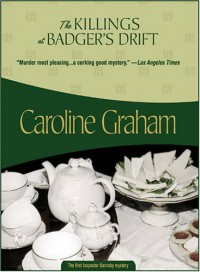 In 1987, Caroline Graham (born in the UK in 1931) published her first crime novel, THE KILLINGS AT BADGER'S DRIFT, which introduced DCI Tom Barnaby and Sergeant Gavin Troy. The book won the Macavity Award for "Best First Novel" (in addition to being nominated for the same honor by the Anthony and Agatha Awards). In 1990, the Crime Writers' Association selected Badger's Drift as one of the top hundred crime novels of all time. The DCI Barnaby series was popular enough to spawn six more installments, but it wasn't until ITV came calling that the fortunes of Graham (and Barnaby) really took off. The televised series Midsomer Murders, based on Graham's books and starring John Nettles, began with an adaptation of "Badger's Drift" in 1997 and is still going strong with new episodes 15 years later.
In 1987, Caroline Graham (born in the UK in 1931) published her first crime novel, THE KILLINGS AT BADGER'S DRIFT, which introduced DCI Tom Barnaby and Sergeant Gavin Troy. The book won the Macavity Award for "Best First Novel" (in addition to being nominated for the same honor by the Anthony and Agatha Awards). In 1990, the Crime Writers' Association selected Badger's Drift as one of the top hundred crime novels of all time. The DCI Barnaby series was popular enough to spawn six more installments, but it wasn't until ITV came calling that the fortunes of Graham (and Barnaby) really took off. The televised series Midsomer Murders, based on Graham's books and starring John Nettles, began with an adaptation of "Badger's Drift" in 1997 and is still going strong with new episodes 15 years later. THE KILLINGS AT BADGER'S DRIFT is set in an idyllic English village of that name filled with stereotypical characters including vicar, bumbling local doctor, and kindly spinster who taught almost everyone in town. When the spinster dies, everyone believes it was natural causes—except for her closest friend, Miss Lucy Bellringer, who is convincing enough that Chief Inspector Barnaby orders an autopsy. When the coroner finds the woman died of hemlock-laden wine, Barnaby and Sargeant Troy begin to peel away layers of scandals and festering resentments in the town that provides them with plenty of suspects. And then, the murderer strikes again, leaving a woman's bloody corpse to be found by her son, the local undertaker...
Caroline Graham manages to channel the Golden Age mysteries and preserve the same small-town English village milieu popularized by Agatha Christie, while throwing in modern touches and a little more violence and sex. Chief Inspector Barnaby and Sergeant Troy are polar opposites and both well-drawn—Barnaby the conservative, thoughtful, married officer with a dry wit, and Troy, the young, handsome, know-it-all. "Publishers Weekly" said that "Graham makes the characters humanly believable in her witty and tragic novel, a real winner," while the "Washington Post" noted "The characters are strong, with a decidedly dark side, and the plot is twisted enough to stump the most astute."
The settings and descriptions are also detailed, astute and quite fun to read, as in this excerpt:
"She was very, very fat. She spread outwards and towered upwards. At least a quarter of her height seemed to be accounted for by her hair, which was a rigid pagoda-like structure: a landscape of peaks and waves, whorls and curls ending in a sharp point like an inverted ice-cream cone. It was the colour of butterscotch instant whip. She wore a great deal of makeup in excitable colours and a lilac caftan, rather short, revealing bolstery legs and tiny feet. The chief inspector fielded her welcoming glance, direct and sharp as a lancet, and introduced himself."
This is a wonderful introduction to Graham, to Barnaby and even to the TV program, although those episodes have veered away from the original material a bit. It's a pity there were only seven books in the series.
More Good Old Stuff
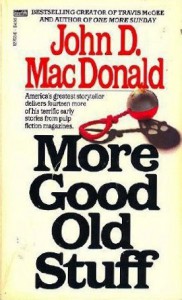 John D. MacDonald, author of over 70 novels, is best remembered for the books featuring Florida-based private eye Travis McGee, who the Washington Post's Jonathan Yardley called "one of the great characters in contemporary American fiction -- not crime fiction; fiction, period." The prolific author actually got his start writing short stories. While he was in the Army in 1945, he sent a short story home to his wife, who promptly typed it up and submitted it to "Story" magazine. The editors bought it for $25, thus giving MacDonald the idea that he could make a career as a writer. He told Ed Gorman in an interview that after leaving the Army, "I wrote eight hundred thousand words of short stories in those four months, tried to keep thirty of them in the mail at all times, slept about six hours a night and lost twenty pounds."
John D. MacDonald, author of over 70 novels, is best remembered for the books featuring Florida-based private eye Travis McGee, who the Washington Post's Jonathan Yardley called "one of the great characters in contemporary American fiction -- not crime fiction; fiction, period." The prolific author actually got his start writing short stories. While he was in the Army in 1945, he sent a short story home to his wife, who promptly typed it up and submitted it to "Story" magazine. The editors bought it for $25, thus giving MacDonald the idea that he could make a career as a writer. He told Ed Gorman in an interview that after leaving the Army, "I wrote eight hundred thousand words of short stories in those four months, tried to keep thirty of them in the mail at all times, slept about six hours a night and lost twenty pounds."He eventually sold over six hundred stories to a variety of magazines in a variety of genres, from mystery to sports, to sci-fi, to westerns, to romances. Some of the publications his stories appeared in included crime pulps like "Dime Detective" and "Black Mask," but he was also published in higher-profile glossy 'zines like "Esquire," "Playboy" and "Cosmopolitan." The stories were included in various anthologies and six collections including THE GOOD OLD STUFF and MORE GOOD OLD STUFF.
The 1984 collection, MORE GOOD OLD STUFF, contains 14 of MacDonald's earlier stories from the pulp mystery/detective magazines of the late 1940s. They include "Deadly Damsel," the story of a professional widow (who has wed and murdered five husbands) and an amateur con man who get fatally tangled in a web of their own devising, from which we get lines like these:
"Death gave her a feeling of power that she bore with her wherever she went. She looked at the dull, tidy little lives of the women in the small cities in which she lived, and she felt like a goddess. She could write all manner of things on the black slate of life, and then, with one gesture, wipe the slate clean and begin all over again. New words, new love, new tenderness and a new manner of death... It was good to kill men..."
Or there's "Death for Sale," about a hired killer with a broken soul who stalks a French Nazi-collaborator to a New Orleans restaurant, where hunter and quarry suddenly trade places. MacDoanld wrote in the Foreword that he was "tempted to clean up some of the very stilted dialogue" and change the gimmick at the end of this story, but it would "be unfair to excise the warts to make myself look better than I was."
MacDonald was almost apologetic in his Foreword about how dated some of the stories were (he updated some minor details because of that), but as he also said, "The events of these stories are in a past so recent they could just as well have been written today. And that is a portion of my intent, to show how little the world really changes." Those words could almost serve as a summary of these early stories; although they lack the polish and the more intense, well constructed plots that were to come, the nugget of great storytelling that marks the author's work is all there and changed very little over time, but just got better.
Poison for the Prince
 Historical mysteries have been around for awhile, but really began to grace the bestseller lists in the 1980s and 90s with the books of Anne Perry (Victorian England), Elizabeth Peters (Victorian and Edwardian England and Egypt) and Ellis Peters (Brother Cadfael in Norman England). Around that era, two women who were former classmates, Jill Staynes and Margaret Storey, decided to pen their own historical mystery series under the pen name Elizabeth Eyre.
Historical mysteries have been around for awhile, but really began to grace the bestseller lists in the 1980s and 90s with the books of Anne Perry (Victorian England), Elizabeth Peters (Victorian and Edwardian England and Egypt) and Ellis Peters (Brother Cadfael in Norman England). Around that era, two women who were former classmates, Jill Staynes and Margaret Storey, decided to pen their own historical mystery series under the pen name Elizabeth Eyre.There were a total of six books, published once per year from 1991 to 1996. Poison for the Prince (1993) is a middle installment in this series set in the Italian Renaissance. Like the other books, it features courtier and sleuth Sigismondo, assisted by his shrewd half-wit servant Benno and a dog named Biondello. In this outing, Sigismondo and Benno are in the city of Viverra, where its weak and near-penniless ruler Prince Scipione is kept in power by high-priced mercenary Ridolfo Rodolfi. Scipione suffers from a chronic illness that the prince's wife and his alchemist attribute to fumes from the laboratory where the Prince works to replenish his supply of gold. Sigismondo, however, suspects poison and has a host of suspects including Scipione's cheating wife, his playboy son, the mysterious alchemist and a charismatic monk who preaches against alchemy.
"Publishers Weekly" noted that "Trailing after Eyre's sleuths is like making one's way through crowded fairgrounds--not much character development, but plenty of entertaining distractions." Kirkus was more complimentary, adding, "Less earnestly didactic than Sigismondo's earlier adventures, but still aswirl in enough Machiavellian plots, moonlit assignations, treacherous hirelings, and summary beheadings to keep you bedazzled in a perpetual haze of Renaissance chiaroscuro."
Sigismondo is an appealing character, once described as a brilliant deductionist who is bald like a monk but who fights like a soldier, while his slack-jawed manservant, Benno, is someone who has an air of amiable idiocy. Although London's publication "The Mail on Sunday" trumpeted that Sigismondo could well be starting a career to equal Ellis Peter's Brother Cadfael, the series never quite took off, and the books are mostly out of print now.
The President's Mystery Plot
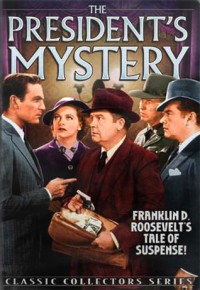 President Franklin Delano Roosevelt once came up with his own idea for a mystery novel. He told magazine editor Fulton Oursler that he'd been carrying around in his mind the plot for a mystery novel for years. His idea? "How can a man disappear with five million dollars in any negotiable form and not be traced?" Oursler suggested they ask the leading writers in the U.S. to collaborate on such a story, to which FDR replied, "Go ahead. See what you can all do with it."
President Franklin Delano Roosevelt once came up with his own idea for a mystery novel. He told magazine editor Fulton Oursler that he'd been carrying around in his mind the plot for a mystery novel for years. His idea? "How can a man disappear with five million dollars in any negotiable form and not be traced?" Oursler suggested they ask the leading writers in the U.S. to collaborate on such a story, to which FDR replied, "Go ahead. See what you can all do with it."Oursler did just that, contacting various authors and challenging them to take "the President's mystery plot" and contribute a chapter to the story by plonking the protagonist, Jim Blake, in a dire situation and then leaving him for the next author in line. The work of the first authors, Rupert Hughes, Samuel Hopkins Adams, Anthony Abbot, Rita Weiman, S. S. Van Dyne, and John Erskine, were serialized in Oursler's Liberty Magazine in 1935, and the book was published in 1936. However, poor Jim Blake was left hanging for thirty years until Erle Stanley Gardner (creator of Perry Mason) came along and tied everything up in a final chapter when the book was reprinted in 1967 and retitled The President's Mystery Plot.
More a literary curiosity than high literature, the book has a bit of camp and zaniness, and true mystery fans may be disappointed in the thin, zigzagging plot and weak characterizations that sometimes accompany collaborative ventures. Still, it was popular enough that a movie was made of the story in 1936, directed by Phil Rosen and starring Henry Wilcoxon as hapless Jim Blake (Marc Antony in Cecil B. DeMille's Cleopatra). It's an interesting period piece, if you can get past the first chapter. Writer Rupert Hughes gave Blake a scheming Russian wife and writes out her dialogue with "phoenetic precision," as Arthur Schlesinger, Jr., aptly notes in his introduction ("Jeem, how you can't see it is beecose I loaf you so dear I cannot deevide your loaf with even some babies?").
More telling may be what the book reveals about Roosevelt himself. When he proposed the idea to Oursler, the hero was conceived as "hating the falsity of his existence, the meaninglessness of his career, the sameness of his middle-aged routine, the absence of purpose and the boredom with his marriage."
 1
1
Murder Ink: Revived, Revised, Still Unrepentant Perpetrated by Dilys Winn
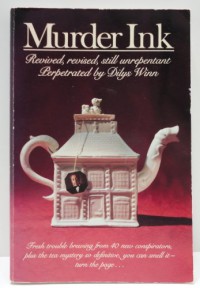 In June 1972, Dilys Winn opened the first specialty bookstore devoted to mysteries and crime fiction. Titled Murder Ink, the store stood on its original spot in Manhattan for 34 years before it had to close in 2006. Winn continued to serve the mystery community even after selling the store in the '70s, with the occasional essay in publications like the New York Times and also by writing reference books. In fact, the bio in one of her NYT pieces indicated she was the author of 17 books, but sadly, most of those are apparently not available.
In June 1972, Dilys Winn opened the first specialty bookstore devoted to mysteries and crime fiction. Titled Murder Ink, the store stood on its original spot in Manhattan for 34 years before it had to close in 2006. Winn continued to serve the mystery community even after selling the store in the '70s, with the occasional essay in publications like the New York Times and also by writing reference books. In fact, the bio in one of her NYT pieces indicated she was the author of 17 books, but sadly, most of those are apparently not available.What is available is the most popular of those books, appropriately titled Murder Ink: the Mystery Reader's Companion, dating from 1977. Once again, it was a Winn-trailblazing-project by being the first of its type, combining a compendium of information on crime fiction with a very large dose of humor. It was so popular, that Winn came out with the revised version in 1984. Whereas the first edition was subtitled "Perpetrated by Dilys Winn," the update is subtitled "Revised, revised, still unrepentant AND perpetrated by Dilys Winn."
The 1984 version contains many of the same features from the original, with a host of essays on Plots, Trouble Spots (settings), Suspicions (suspects), Crimes, Victims, Bloodhounds (detectives), Motives, Justice and some miscellaneous fun in Side-Tracked and Complications. Contributors to the book include reviewers like Marilyn Stasio with the New York Times; authors including Ed McBain, Martha Grimes, PD James; publishers like Otto Penzler; and dozens of other "first-time offenders," recidivists," and "imposters."
Also new to this edition is a "book within a book." It's a story titled "The Tainted Tea Tragedy," told on the first three pages of each chapter, with two clues to a chapter and additional clues scattered throughout the book. There's even a mirror-image recap of the aftermath one year later in the Index, although "those who peek are "despicable beyond words."
Fun interstitials are sprinkled throughout the book, too. You'll find cartoons like an illustration of the authentic classic private eye trenchcoat, appropriately labeled; sidebars galore filled with trivia, quotes and poems; bibliographies; glossaries and lots of literary eye candy. There's also a section on the crime fiction awards categories, although there is one award missing: the Dilys Award. In 1992, well after this book was published, the Independent Booksellers Association created the award for the mystery titles of the year that member booksellers have most enjoyed selling. They named it after—who else? Dilys Winn.
The Trouble With Product X
 Joan Aiken (1924-2004) began her writing career with YA fiction as a 16-year-old contributor for the BBC Children's Hour. Aiken's efforts at mysteries and suspense novels won her an Edgar Award for Best Young Adult Novel (Night Fall) in 1972. The same touch of the quirky, whimsical inventiveness in her writing for young people often found its way into her adult crime fiction. She once said, "Stories are like butterflies, which come fluttering out of nowhere, touch down for a brief instant, may be captured, may not, and then vanish into nowhere again."
Joan Aiken (1924-2004) began her writing career with YA fiction as a 16-year-old contributor for the BBC Children's Hour. Aiken's efforts at mysteries and suspense novels won her an Edgar Award for Best Young Adult Novel (Night Fall) in 1972. The same touch of the quirky, whimsical inventiveness in her writing for young people often found its way into her adult crime fiction. She once said, "Stories are like butterflies, which come fluttering out of nowhere, touch down for a brief instant, may be captured, may not, and then vanish into nowhere again."Trouble with Product X (aka Beware of the Bouquet) dates from 1966 and is one of the author's earlier novels for adults. Product X is a new perfume to be manufactured by a small company aiming to go upmarket. The ad agency hired to handle the promotion is Salmon & Bucknell, including employee Martha Gilroy, who suggests shooting a television commercial in the same remote Cornish castle where she spent her honeymoon—before her husband had a nervous breakdown and left her.
Another bad idea is to use the beautiful young Italian wife of the client as a model, as it soon becomes clear she's at the heart of a conspiracy regarding the origin of Product X. The remote TV shoot soon turns into a parade of nightmares and intrigue, including the kidnapping of a baby; monks who oppose the filming and one particularly mysterious monk who Martha thinks she recognizes; a venomous spider mailed as a "gift"; exploding soup cans; and an assortment of gothic thrills and chills that will please fans of Mary Stewart.
As The Telegraph said in Aiken's obituary, you could usually count on "slightly scatty but independent-minded young women who end up marrying slightly scatty but charming young men. Mysterious, corridor-ridden Gothic houses figure prominently, along with a variety of curses and enchantments. And there is always a strong sense of right and wrong." Although bits of that formula are present in Product X, so too is Aiken's trademark humor:
"I spent a moment or two wondering where the devil I was, who the devil I was, in a weak and lackadaisical way...My mind wobbled about like a half-set jelly, full of unrelated fragments: the address of a man I'd meant to write to about detergents before coming down to Cornwall, lines from Twelfth Night, the fact that my library subscription needed renewing, a series of slogans for Bom which I'd been trying to hatch on the way down. 'Whether you're coming or going, mending or mowing, scything or sewing, reading or rowing...you need Bom, the meat'n milk drink, made from pure fresh milk and lean juicy beef. Bom, tiddly, om BOM!' I can't offhand think of any nastier beverage than Bom, but at that moment, I felt hazily that I might even have accepted a cup of the stuff if someone had offered it to me, hot."
Martha tends to muse perhaps a bit too much on Bom promotions while she's in the midst of danger, but ultimately she proves to be an insightful sleuth, even as she fights her feelings for her ex and for a fellow employee who seems to be taking a suspiciously keen interest in the client's beautiful wife. The plot isn't so much a whodunit as a pleasant modern (albeit 1960s) Gothic romp.
The Adventures of Romney Pringle
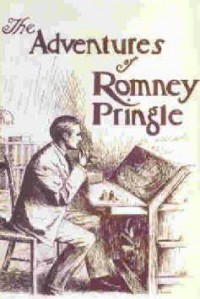 British author R. Austin Freeman (1862-1943) primarily wrote detective stories and is best known for his legal/forensic investigator Dr. John Thorndyke, using Freeman's early experiences as a colonial surgeon to help inspire and inform his work. Freeman is credited with inventing the inverted detective story, where the identity of the criminal is shown from the beginning, demonstrated in some of the stories included in this volume:
British author R. Austin Freeman (1862-1943) primarily wrote detective stories and is best known for his legal/forensic investigator Dr. John Thorndyke, using Freeman's early experiences as a colonial surgeon to help inspire and inform his work. Freeman is credited with inventing the inverted detective story, where the identity of the criminal is shown from the beginning, demonstrated in some of the stories included in this volume:"The Assyrian Rejuvenator"
"The Foreign Office Despatch"
"The Chicago Heiress"
"The Lizard's Sacle"
"The Paste Diamonds"
"The Kailyard Novel"
As Bob Schneider noted for GA Detection, Romney Pringle lives by his wits and keen observational powers, being a consummate student of human nature. The "gentleman" moniker is relevant to the handsome, charming Pringle because runs a pseudo literary agency, eschews violence and—-when not participating in his criminal pastimes of patent medicine fraud, forgery or burglary—-enjoys fine art, bicycling and boating. He's also a master of disguises and has skills that help him track down his prey, usually other criminals, including experience in chemistry and gemology.
Freeman had a detailed and personal knowledge of the backstreets of London, Highgate and Hampstead in the years prior to World War II, and his descriptions are one of the most charming aspects of his writing, counting no less than T.S. Eliot and Raymond Chandler as fans. There are criticisms, too, including Freeman's tendency to be repetitive in certain catch-phrases, dialogue, settings and character types, but such quibbles can be overlooked in the grander scheme of Freeman's storytelling.
Detective Fiction: Crime And Compromise
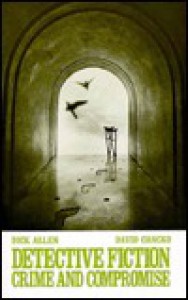 "Detective Fiction: Crime and Compromise" by Dick Allen and David Chacko from 1974, is an anthology apparently intended for a college class on detective and mystery fiction—or as it states in the Preface, "a form of popualr fiction that is forever concerned with the basic questions of 'right' and 'wrong' in human behavior."
"Detective Fiction: Crime and Compromise" by Dick Allen and David Chacko from 1974, is an anthology apparently intended for a college class on detective and mystery fiction—or as it states in the Preface, "a form of popualr fiction that is forever concerned with the basic questions of 'right' and 'wrong' in human behavior."Allen and Chacko included short stories, selected passages from novels, two poems, and a final section of essays by writers in the genre, organized into four sections: Manifestations, The Detective, The Genre Extended and Theories. Each selection is followed by analytical questions, and there also an appendix with topics for writing and research, a bibliography and some suggestions for further reading. Something I also appreciated from the Preface: "The genre as a whole has too long been ignored in the classroom."
The first section is designed to give an overall perspective on some metaphysical questions regarding the genre, and Allen and Chacko chose an unusual opening, Robert Frost's poem "Design," which poses an initial question about the presence of evil and horror in the world. Just to show that the definition of crime fiction can cast a wide net, the section also includes Ernest Hemingway, Graham Greene, Robert Louis Stevenson, Robert Browning and Agatha Christie.
The section on the Detective is a good overall overview of the topic, while The Genre Extended casts the net even wider to demonstrate how the element of "detection" operates in all forms of literature like "The Tree of Knowledge" by Henry James. And, as the editors point out, Ross Macdonald and Dashiell Hammett demonstrate how the gap between pure detection stories and "literary" fiction narrowed. The final section, Theories, begins with Dorothy L. Sayers' examination of the genre's history and winds its way to Fred P. Graham's essay, "A Contemporary History of American Crime." It also includes the Raymond Chandler essay "The Simple Art of Murder."
Although I wasn't able to find much on how well the book was received by student readers, this near 40-year-old book is among the first to give crime fiction the respect it is rightfully due. An interesting side note: one of the editors, Dick Allen, is primarily a poet who became Connecticut State Poet Laureate in 2010, and I find it interesting he chose this topic as one of only a few nonfiction books he has published. But then, the very best crime fiction has poetry at its heart, one reason perhaps that "Esquire "called George Pelecanos "the poet laureate of D.C. crime."
The Awareness
 Terrie Moran has a lovely way with words that adds a rich emotional subject layer to her stories. These seven tales are all quite different in theme and plot, yet united in their ability to draw you into their world, be it through the eyes of vengeful banshee in THE AWARENESS or the travails of a horserace-fixer who's pulled into a fiendish plot in the noir tale WHEN A BRIGHT STAR FADES (which received a well-earned nod as a "distinguished mystery of 2008"). Terrie also sneaks in plenty of sly humor to balance out the dark-edges, making these stories a pleasure to read.
Terrie Moran has a lovely way with words that adds a rich emotional subject layer to her stories. These seven tales are all quite different in theme and plot, yet united in their ability to draw you into their world, be it through the eyes of vengeful banshee in THE AWARENESS or the travails of a horserace-fixer who's pulled into a fiendish plot in the noir tale WHEN A BRIGHT STAR FADES (which received a well-earned nod as a "distinguished mystery of 2008"). Terrie also sneaks in plenty of sly humor to balance out the dark-edges, making these stories a pleasure to read.



